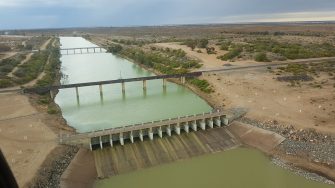
Date: Tuesday, October 16, 2018
Project: Eastern Australian Waterbird Survey
Observer: John Porter
Heading out of Broken Hill to Menindee Lakes we are relieved to find the previous day's dust storms have subsided and visibility has improved markedly. There are reasonable numbers of Grey teal on Lake Cawndilla which is about 50% full and drying, creating large areas of shallow habitat that attract ducks and shorebirds. Most of the other lakes in this system are dry with low or moderate numbers of waterbirds. A recent study by the Department of Primary Industries has found that Lake Cawndilla is critically important breeding habitat for breeding of native fish species. Copi Hollow and Lake Pamamroo are almost full but support relatively low numbers of waterbirds.
Lake Cawndilla shallows and mudflats
Lake Menindee regulator looking northward towards Copi Hollow
From Menindee we head south to Renmark and Band 3 of the survey before heading east to Noora Evaporation Basin. These shallow saline wetlands have been improved by local community groups to increase habitat where we found moderate numbers of black swan, avocet, stilts and shorebirds. As we fly over we see many hides and blinds used by the hunters dotted around the wetland.
Irrigated farmland and the Murray River floodplain near Renmark
Further eastward we find most of the natural wetlands of the Raak Plains are dry and there are no waterbirds; our final task for this leg is to count along part of the Murray River northwards before heading into Mildura to refuel. From Mildura the weather deteriorates rapidly into thunderstorms, rain and the occasional lightning strike to make the day more interesting. Dodging the storms and poor visibility we head into the Lowbidgee wetlands which have been strongly affected by the ongoing drought. Yanga Lake supports a fine mob of pelicans and moderate numbers of Grey teal but there are few other highlights. We continue east over the mostly bone dry wetlands before finishing in Griffith for the day.
